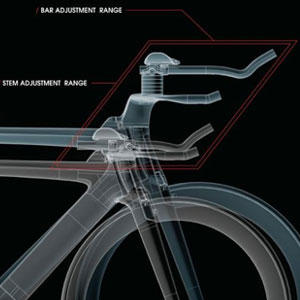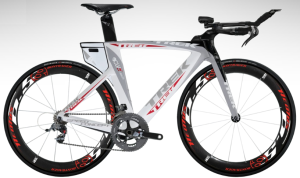
In all likelihood Speed Concept wasn't on your radar three months ago. I write this with confidence, even though I don't know who "you" are. This, because the hype hadn't started, and, prior to a month ago we only saw brief glimpses of this bike underneath the occasional Trek sponsored pro.
Now, there's flesh on the bikes of the Speed Concept, and all the flesh is sexy. But like every Playboy playmate, the warts are not apparent. Mind, even if we saw the playmate in real life, warts and all, we might still be favorably impressed. Nonetheless, whether you contemplate bringing a Speed Concept, or a playmate, home with you for an extended stay, you'll want to familiarize yourself with the entire package, warts and all, so that you know what you're signing up for.
In that spirit, here's my best analysis of the Speed Concept from every angle.
If you spend time with Trek's Speed Concept white paper you could be forgiven if, upon finishing the document, you immediately rush down to your local Trek outlet and plunk down a deposit. And make no mistake about just how impressive the Speed Concept project was and is. After reading my attempts below to place the Speed Concept into a proper context versus the other bikes in its competitive set (and Trek's own downstream versions of what it presents in its white paper) you still may lay down your deposit.
If after reading what's below you do rush out and buy a Speed Concept, then, you'll probably do so with increasing confidence that it's the right bike for you.
Just know that the white paper compares the Speed Concept 9 Series to bikes made by Cervelo, Specialized, and the like. Let's talk about the 9 Series.
9 SERIES
These are complete bikes that carry MSRPs of $5,770, $7,090, and $8,920, for the 9.5, 9.8 and 9.9 respectively. Each of these bikes comes with Bontrager aero bars, and, they must only be ridden with Bontrager aero bars. If you don't like these Bontrager bars, you'll spend between $6000 and $10,000 (out the door) for a bike with aero bars your forearms are at war with. There is no changing these aero bars, and there is no changing the pursuit bar underneath the aero bars (absent using Trek's "steerer stub," more on that below).
One element of modularity available to you without ditching the Speed Concept's built-in stem is to change to an extension made by another company, and assuming that company makes an armrest system that clamps onto the extension. Profile Design makes aerobars in this theme, as did the Blackwell company while it was in business. Conversely, you might keep Bontrager's armrests, but simply use another company's extension. This, because Bontrager does use 22.2mm as its extension tube diameter. So there is some modularity available when using Bontrager's bars on the 9 Series Speed Concept.
But what you can't do is lower what seems a moderately high-profile style of armrest, if you want to use one of the Speed Concept's stems. This may matter to you, whether you know it or not.
Take me as an example. I'm a very good fit lengthwise on the largest size of the Speed Concept. This, because I'm medium-tall (6'2"); I ride steep (79.5° of seat angle, BB thru the saddle rail midpoint); and I'm moderately long in the torso. This requires a fairly long tri bike, and the Speed Concept in 60cm has a reach of 44.5cm. This is to the millimeter the reach of Cervelo's P3 in 58cm, and this is a geometry with which I'm very happy.
But the Speed Concept in this 60cm size has a stack of 56.5cm, versus a stack of 53.5cm in the P3. Really, I'm a rather good fit on something in between these two metrics, and the P2's stack of 55cm is just about perfect for me. So, the Speed Concept is pretty close to my perfect geometry, no?
Well, yes and and no. It's pretty close if I have enough wiggle room in terms of the front end I place on the bike. But, I don't have a lot of wiggle room. With the 9 Series I have three stem configs to choose from in terms of height, and two in terms of length. If I'm happy with the Bontrager aerobar's ergonomics, then, I'll probably opt for the "low/far" stem option. Remember, these 9 Series stem options are as follows:
Low/Near: 10mm rise, 50mm reach
Low/Far: 10mm rise, 100mm reach
Mid/Near: 45mm rise, 60mm reach
Mid/Far: 45mm, 100mm reach
Tall/Near: 75mm rise, 80mm reach
Tall/Far: 75mm rise, 110mm reach
This "low/far" stem will be my likely choice because I ride a 90mm stem on my P3, and, if that 100mm stem is a smidge too long, I can normalize by moving the Bontrager extensions back 10mm and, since the armrests mount on the extensions, the bike's entire cockpit moves aft in concert.
This, assuming the "low" version of the Series 9 "stem" is "low" enough for me. Remember, I prefer, in general, fairly low profile aerobars. Yes, I ride a semi-high profile aerobar on my P3 (3T's Ventus bar), but, the P3 sits 3cm lower than does the Speed Concept in a size with the corresponding length as my P3.
Bottom line, can I get the Speed Concept low enough in its 60cm size? If I can't would I be willing to ride the next size down? Maybe. If I do resort to this, I'm riding a bike with a front/center 2cm shorter, which is a weight displacement I'm less happy with (those who follow the tales of my own attempts to fit aboard bikes might remember that this shorter front/center was one of my concerns when setting up my Cannondale Slice).

Thankfully, Trek has anticipated my dilemma, and it offers a "steerer stub" (pictured adjacent). This converts the 9 Series models into a bike style you're more familiar with. With the steerer stub you can place any 1-1/8" stem on the bike, and, any aerobar you want. This converts a 9-series bike into something I can easily fit aboard. I keep the other aerodynamic elements native to the 9 Series, specifically the fork and the recessed brake calipers, but, I gain the modularity to use my choice of aerobar.
But there are is yet another option for me, and I'll get to that in a few paragraphs.
AERODYNAMICS
The Speed Concept has a ton about it that I really admire. Spend some time looking at the way its cables, its electronics, its system for carrying spare tubes and inflators (the name of which—the Draft Box—I keep forgetting, so I refer to it as the "trunk"), and the brake calipers. These are all issues you'll have to contend with on any bike and, to the degree that Trek has found a way to integrate (for example) tire bags and bike computers into its frames, these killers of aero features won't kill the aero features of the Speed Concept.
Then there's the Kamm Tail theme throughout all the Speed Concept's models, all the way down to entry level. It's a great narrative, and the white paper presents data that validates that narrative. Just remember, though, that every bike maker—Trek, Specialized, Cervelo—makes bikes that have a "natural" best aero posture. For example, if Bike A, with a -17° stem in a 100mm length, mounted with a particular aerobar, is tested by Company A, then all the competing companies' bikes must be made to conform to Bike A's configuration. If that means Bike B—a nominally longer, lower bike—must be config'd with a +8° stem to match Bike A's config, then Bike B's drag suffers accordingly.
Bottom line: Best if you peruse the Slowtwitch Reader Forum, and read the "peer review" whenever Cervelo, Specialized, Trek, or any other company produces the results of its wind tunnel testing. We have some smart people on this forum, and they'll likely uncover elements of the testing protocol that should be open to scrutiny. Last I looked, there was a thread containing about 300 posts on Trek's testing of this Speed Concept. It's worth a read.
7 SERIES
The compelling aerodynamics in Trek's white paper attends the 9 Series of the Speed Concept. But the 9 Series is the most restrictive of the Speed Concept models. I can't choose a different aerobar, I can't choose a low profile aerobar, and I'm restricted to choosing from among stems that might not allow me to ride the 60cm Speed Concept with the 15.5cm of armrest drop specific to my fit coordinates, unless I resort to using the steerer stub.
But, if I can't get to my desired armrest drop on the frame size with the length I'd prefer to ride, there's yet another option: the 7 Series Speed Concept. This frame is almost identical to the 9 Series on every element behind the head tube. In that sense, it's like Felt's frames. The Bayonet fork that is the hallmark of Felt's models above a certain threshold make Felts different from their bikes below that price threshold. But the Felt frame silhouette is otherwise identical once you're behind the Bayonet fork.

Likewise the 7 Series Speed Concept. All the Kamm Tail features are the same, and, all the electronic accessories, and the "trunk," bolt right into pods on the 7 Series frame built for the purpose.
And, the 7 Series frames are more price palatable. These complete bikes range from about $2,500 to $3,700.
But what I like most about these 7 Series models is their modularity. While the complete bikes are spec'd (of course) with Bontrager, I'm not limited to Bontrager aerobars. Nor am I limited to the 9 Series stem options. This means that I certainly can ride the 60cm Speed Concept if I want to, and I can ride it with my aerobar preference.
The question is, what does the 9 Series stem give you aerodynamically? If you choose not to use the stem, and prefer the increased modularity afforded you thru the use of the steerer stub, are you better off just saving your money and choosing the 7 Series model? Trek says the silhouette of the 9 Series fork, and the recessed brake calipers, accounts for about half the aero benefit of the 9 Series frame over the 7 Series (the stem the steerer stub replaces gives you the other half). Plus, the 9 Series frame is about 200 grams lighter per size than the 7 Series. Decisions. Decisions.
In any case, if you are as picky as I am about fit coordinates and contact points, you might find yourself in this quandary. This assumes the lack of modularity in 9 Series bikes causes you any ergonomic or geometric issues.
Just remember, though, that once you move from the 9 Series to the 7 Series, or opt to use the steerer stub, some of those garish drag numbers go away.
What I can tell you about the Speed Concept is that it's the best step forward that any bike company has made in its tri bike offerings since Felt's 2007 season, when Felt dumped its entire line of mediocre designs and debuted the lineup you pretty much see from that company today. Trek is now a serious player in the tri bike business. The Speed Concept is a haymaker. It's Joe Frazier's left hook, and Kareem's sky hook.
Just, buy the right Speed Concept for you, and, if and only if the Speed Concept is your right bike. There's a lot I'm leaving out today, including a perusal of each bike's spec, and the value delivered per model. We'll have a lot more to write about these bikes in the upcoming months, as we overview them model by model, just as we overview every tri model made by Scott, Cervelo, Specialized, Felt, QR and every tri company.


